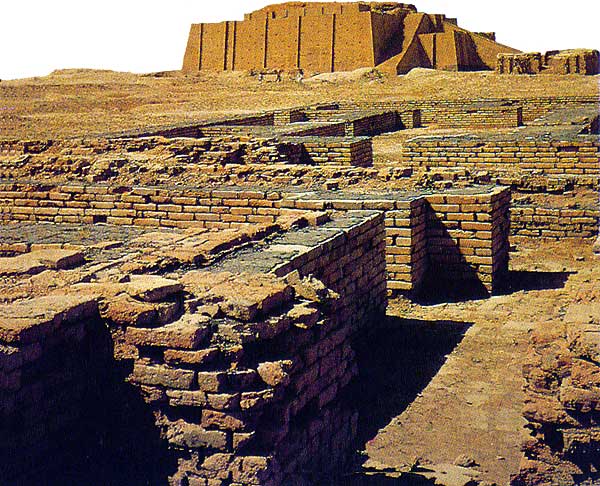CITY OF UR
The Forgotten Glory of Ur: A Colorful Archaeologist and a Spectacular City Held the Public Eye
Terah took Abram his son and Lot the son of Haran, his grandson, and Sarai his daughter-in-law, his son Abram’s wife, and they went forth together from Ur of the Chaldeans to go into the land of Canaan, but when they came to Haran, they settled there.(Gen.11:31)
Now known as Tall al Muqayyar, the Sumerian city of Ur, home to the biblical patriarch Abraham, is located near the Euphrates River, approximately halfway between the present day Iraqi capital Baghdad and the shore of the Persian Gulf. It was first found and excavated in 1853 and 1854 by British consul J. E. Taylor, who uncovered the then sand-covered remains of the famed ziggurat of Ur which was dedicated to the moon god Nanna in Sumerian mythology and the Babylonian equivalent Sin in Babylonian mythology. However, the excavation of the actual city did not happen until 1918 when the British Museum funded an excavation under the leadership of British archaeologists Reginald C. Thompson and H. R. H. Hall. Though excavation ceased in 1919, it was restarted in 1922 in a joint expedition by the British Museum and the University Museum of the University of Pennsylvania under the direction of British archaeologist Sir Leonard Woolley. Ending in 1934, this last expedition was the one that provided the most information on this mighty city of over 200 000 residents at its peak.
Due to a lack of modern excavation technology, most, if not all, of the sand-covered ruins would be excavated by the hands of labourers with the simplest of digging tools – shovels and picks. They also lacked a systematic approach to the excavation that is used today. Because archaeological discoveries brought recognition to the archaeologists and institutions who conducted them in the early twentieth century, the 1922-1934 excavation of Ur by Sir Leonard Woolley was one of the most expansive archaeological excavations in history – employing the labour of hundreds of workers. The workers uncovered entire sectors of the most recent city and the various strata containing evidence of civilization underneath the site, tracing the city to its origins as a small farming community in 4700 BC. Excavating the site was a tedious task, as the sun-dried mud-bricks used to construct the structures were the same colour as the clayey soil and sand that surrounded them, making them almost indistinguishable.
Many great discoveries were made at Ur, the centre of Sumerian culture, but how did archaeologists know that the site was actually Ur? The answer came during the excavation of the ziggurat by Taylor, when several clay cylinders, inscribed in cuneiform, identified the site as “Ur of the Chaldeans,” regardless of the fact that the rest of the city was covered by sand at the time. Findings at the site revealed the various stages of the city’s history throughout the reigns of different monarchs, as well as their tombs. For example, inscriptions on tablets found in Ur revealed the code of Ur-Nammu, the first king of the 3rd dynasty of Ur, which was the second, but most effective, system of laws and punishments in Mesopotamia. Among the greatest discoveries at Ur, however, were the tombs found at the site – over 1850 burials were uncovered, with 16 of those being part of the Royal Cemetery, where the monarchs were buried. Most of these royal tombs were dated to 2600 BC. Of these tombs, the tomb of Queen Puabi is perhaps the most renowned because it has not been looted for the treasures, meaning that it contained many works of art and valuable objects. The tomb also revealed and confirmed that servants of the monarch would be sacrificed once the king or queen they served died. Furthermore, the greatest impact upon history made by the discovery of Ur is that it confirms the existence of the recorded homeland of Abram (later Abraham) in the Bible before his migration to Canaan, “Ur of the Chaldeans,” though not the person himself. Finally, Woolley’s expedition revealed a layer of silt below the earliest settlements – alleged to have be caused by the Deluge (the global flood recorded in the Book of Genesis), though many scientists believe this merely indicates that the area was prone to flooding because of its geographic location.
The discovery of Ur is a legacy because it gave modern civilization a greater understanding of what life was like at the dawn of civilization. The area around Ur is an excellent place to look for such details as Ur was the capital of Sumer at its height and it was there that the first cities, laws and punishments, and the first form of writing developed. The excavation also brought to light the agricultural revolution – development of agriculture at its earliest stages. Nevertheless, Ur is removed from the list of mythical cities with this discovery. Of course, it is important to learn and understand the past because it holds many lessons even for the modern era. The criminal codes revealed what kind of crime happened at the time of Ur; amazingly, they are strikingly similar to the crimes today – theft, fraud, and murder – meaning that humans have not changed much even after 6000 years. Finally, the site also provided insight into how early nomadic humans developed new technologies to make their lives more efficient – so efficient they no longer have to follow animals for food and instead, depend on themselves for food. It is this same spirit that continues to guide the people of the modern era, and hopefully, the future generation.




Comments
Post a Comment